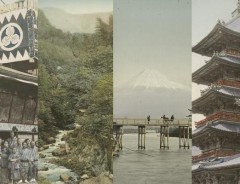Related Article
-

Early Hand-Colored Photography Of Japan Gives Us A Window Into The Past
-

What Makes This Egg So Big? When You Crack It Open… Whoa!
-

Clever Dude Makes A Thor’s Hammer Only He Can Lift And Trolls Locals!
-

Ask your Japanese friends this ONE question!
-

The History Of Japan, Wrapped Up In Just 9 Funny Minutes
-

Strange Foot Disease Has a Simple Diagnosis



1,400 years ago Japan was undergoing significant changes. The introduction of Buddhism into the country had led to the development of Japanese literature, art, society and politics. As written scripts began documenting Japan’s history, culture and knowledge within the Nihon Shoki, one event in particular which happened in 620 was recorded and has continued to baffle historians and scientists ever since.
The event in question is recorded as happening on the 30th of December, 620 CE and saw a strange scarlet red fan spread across the Japanese sky. Described in the historical records as being shaped like a pheasant tail with a length of more than 1 jō 丈 (equivalent to 10 degrees), you can imagine the bewilderment and wonder that came to the witnesses at the time. In traditional Japanese culture pheasants are believed to be the messengers from the gods, so it is understandable that this particular “red sign” was interpreted by many to be a bad omen.
Illustration by Numata Kashu (1838-1901) source: © rawpixel.com
Ever since it’s documentation, the event has caused excitement and confusion amongst astronomers, meteorologists, and physicists. With not much more than ancient texts (which need to be translated into modern Japanese) and stories that have been passed down through the generations to go by, it has been difficult to decipher the reason behind the puzzling display. Now, almost a millennium and a half later, researchers from the National Institute of Polar Research and the Graduate University for Advanced Studies in Sokendai, Japan believe that they may have found the answer.
In a statement by EurekAlert!, Ryuho Kataoka, a researcher at the institute explained, “It is the oldest Japanese astronomical record of a ‘red sign’. It could be a red aurora produced during magnetic storms.”
This wouldn’t be the first time that an aurora has been hypothesised as the cause of the strange incident. Historians and astronomers alike have assumed for centuries that the reason behind the display was either an aurora or a comet. Although both ideas have also been continuously rejected by the scientific community as they each have holes in their theories; the Aurora Borealis (also known in popular culture as the northern lights) do not typically resemble the shape of a pheasant’s tail and a comet does not appear red, and instead flashes colours of white, yellow or green.
To fully understand what had happened so long ago, Kataoka and his team had to look at the facts in a different way. They discovered that the magnetic latitude of Japan 1,400 years ago was at 33 degrees, compared to 25 degrees today and concluded that Japan was much more likely to have experienced auroras at the time. Diving further into their theory, the team created simulations of powerful magnetic storms and found that the results suggested that shapes not typical of current aurora borealis (ribbons and waves) could be created under these conditions. To complete their findings, the team noted how the recorded size of the display - of about 10 degrees - is also compatible with what an aurora affected by a magnetic storm would create.
The team published the results of their study on March 31, 2020 in the Sokendai Review of Cultural and Social Studies. Following their explanation of the “red sign”, the researchers can’t wait to get their hands on more ancient texts with unexplained phenomena that they can try to find an explanation for using modern science and technology.